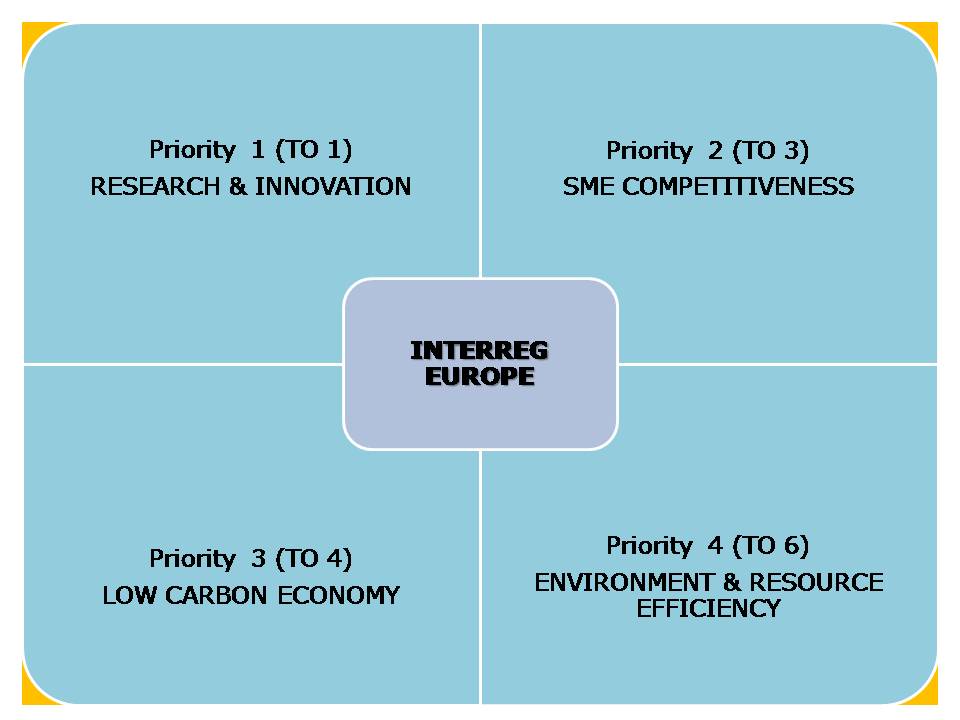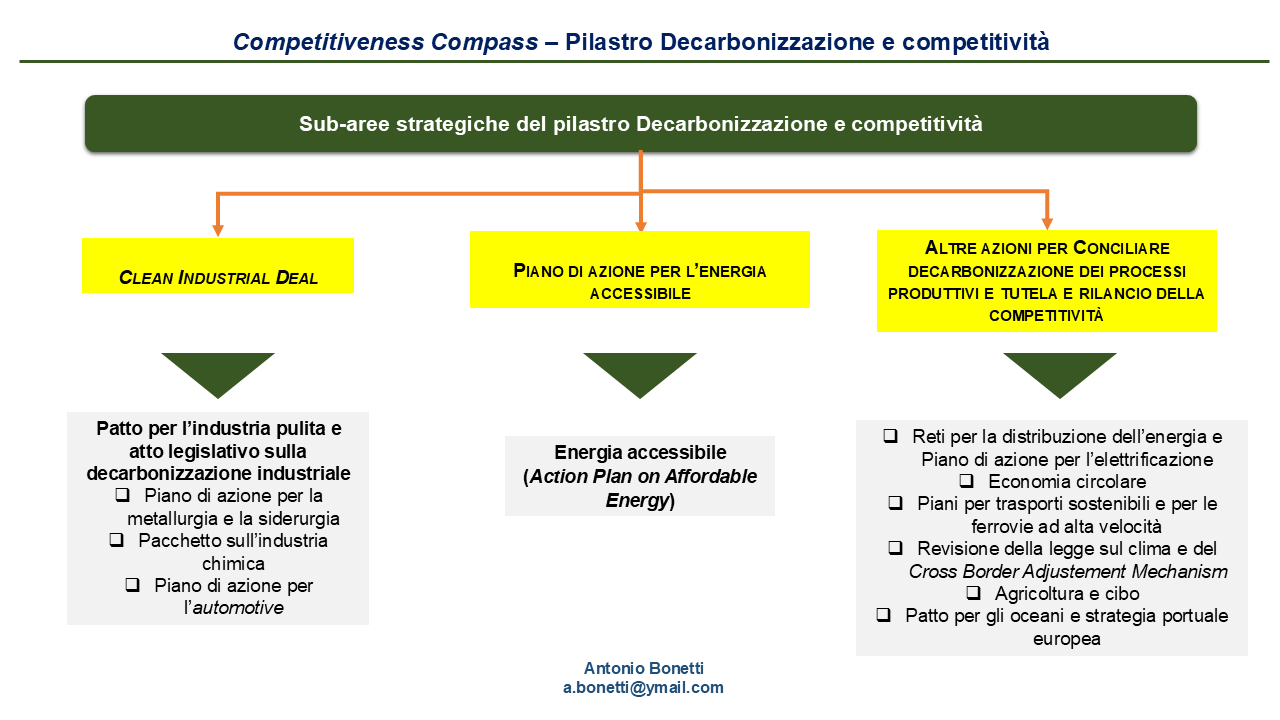Interreg Europe at a glance
Interreg Europe is a particular Programme that builds upon the positive legacy of the Community Initiative “Interreg” launched in 1990.
Under the reformed cohesion policy, Interreg Europe is aimed at ‘sharing solutions for better regional policies’, being part of the European Territorial Cooperation objective of the so-called ‘cohesion policy’. [1]
The whole Programme can be summarized according to a ‘4×2’ scheme:
- four themes (Priority Axes) chosen among the 11 Thematic Objectives that establish a logic link between the “Europe 2020” strategy and interventions co-financend by European Structural and Investment Funds – ESIFs (see the chart below) [2],
- two types of actions, id est (i) policy learning platforms aimed at enhancing knowledge sharing between regional/local authorities, research institutes and other organizations willing to improve regional policies and (ii) cooperation projects.
Chart: Priority Axes of Interreg Europe
The second call
The opening date for the second call under Interreg Europe is set on 5 April 2016 and applications will be accepted until 13 May 2016.
Since the beginning of March is available on the Programme website the whole Application Package approved by the Monitoring Committee [3].
The goal of the 2nd call for proposals is to finance projects testing bold ideas and new knowledge sharing practices on the following Programme’s specific objectives:
1.1. Improve the implementation of regional development policies and programmes, in particular in the field of research and innovation infrastructure and capacities (Priority Axis 1);
1.2. Improve the implementation of regional development policies and programmes, that support the delivery of innovation by players in regional innovation chains (Priority Axis 1);
2.1. Improve the implementation of regional development policies and programmes, supporting SMEs in all stages of their life cycle, to develop and achieve growth and engage in innovation (Priority Axis 2);
3.1. Improve the implementation of regional development policies and programmes, addressing the transition to a low-carbon economy (Priority Axis 3);
4.1. Improve the implementation of regional development policies and programmes, in the field of the protection and development of natural and cultural heritage (Priority Axis 4);
4.2. Improve the implementation of regional development policies and programmes, aimed at increasing resource-efficiency, green growth and eco-innovation and environmental performance management (Priority Axis 4).
 Furthermore, the terms of references highlights that many projects financed under the first call are related to Priority Axis 1 (Research) and Priority Axis 2 (Enhancing competitiveness of SMEs). Accordingly, eligible applicants are advised to submit innovative projects mainly related to Priority Axes 3 and 4.
Furthermore, the terms of references highlights that many projects financed under the first call are related to Priority Axis 1 (Research) and Priority Axis 2 (Enhancing competitiveness of SMEs). Accordingly, eligible applicants are advised to submit innovative projects mainly related to Priority Axes 3 and 4.
All the proposals will be evaluated against eligibility and quality criteria (two-step assessment procedure). Quality criteria are grouped in two categories:
- strategic assessment criteria (relevance of proposals, quality of expected results, quality of partnership),
- operational assessment criteria (coherence of the proposal and quality of approach, communication and management, budget and finance).
Eligible organisations that can apply are: (i) public authorities, (ii) public law bodies, (iii) private non-profit bodies. Interreg Europe Programme Manual clearly indicates the target groups for each specific objective of the call.
Co-financing rates are set as follows:
- 85% of the total eligible cost for public bodies and bodies governed by public law from all 28 EU partner states;
- 75% of the total eligible cost for private non-profit bodies from all 28 EU partner states. [4]
*************
[1] Today, Interreg V (European Territorial Cooperation) is the 2nd objective of ‘cohesion policy’, holds its own regulation – Reg. (EU) No 1299/2013 – and its financial envelope amounts to about EUR 9 billion (2.75% of the total ‘cohesion policy’ budget as reffered to in Article 4 of the ETC regulation).
Article 2 of the Regulation (EU) No. 1299/2013 establishes that the European Territorial Cooperation goal of ‘cohesion policy’ is structured around three components:
- Cross-Border Cooperation programmes (they cover internal and external borders of the EU),
- Transnational Cooperation programmes (15 cooperation programmes),
- Interregional Cooperation programmes.
Furthermore, Article 2 highlights that ‘interregional cooperation’ is aimed at reinforcing the effectiveness of ‘cohesion policy’ by promoting:
(i) exchange of experience focusing on thematic objectives […] and on the identification and dissemination of good practices (Interreg Europe);
(ii) exchange of experience concerning the identification, transfer and dissemination of good practices in relation to sustainable urban development, including urban-rural linkages (URBACT);
(iii) exchange of experience concerning the identification, transfer and dissemination of good practices and innovative approaches in relation to the implementation of cooperation programmes and actions (INTERACT);
(iv) analysis of development trends in relation to the aims of territorial cohesion (ESPON).
[2] Interreg Europe Programme is structured as follows:
- Priority Axes (corresponding to Thematic Objectives 1, 3, 4 and 6 of European Structural and Investment Funds),
- Investment Priorities,
- Specific Objectives.
[3] Interreg Europe will be one of the financial instruments of the EU presented during the workshop ‘New funding models for the Italian Public Administration’ organized by the research centre CEIDA (Rome, 5th and 6th of April). My colleague Elena Zanella, founder of the professional network Fundraising Virtual Hub, and I will present new ideas on how to diversify and ameliorate funding models of Local Authorities, even by raising private donations and using ‘civic’ crowdfunding.
[4] It has to be taken into account that Norway and Switzerland are full members of the Programme, but organizations from these countries are not eligible to ERDF funds.










